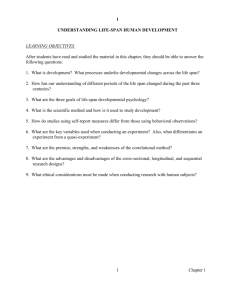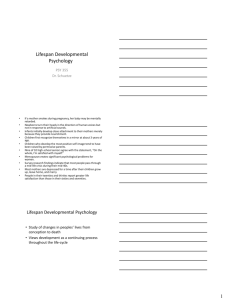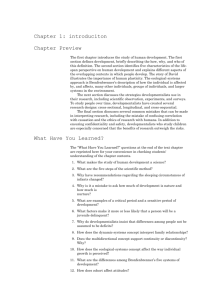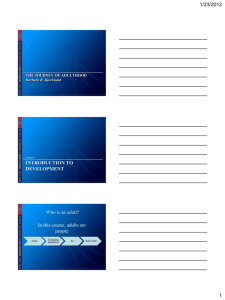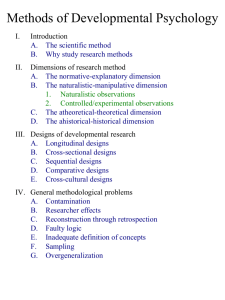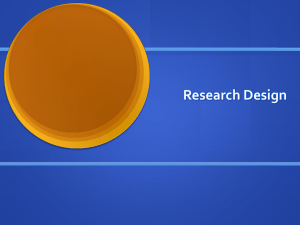DEFINING DEVELOPMENT
advertisement
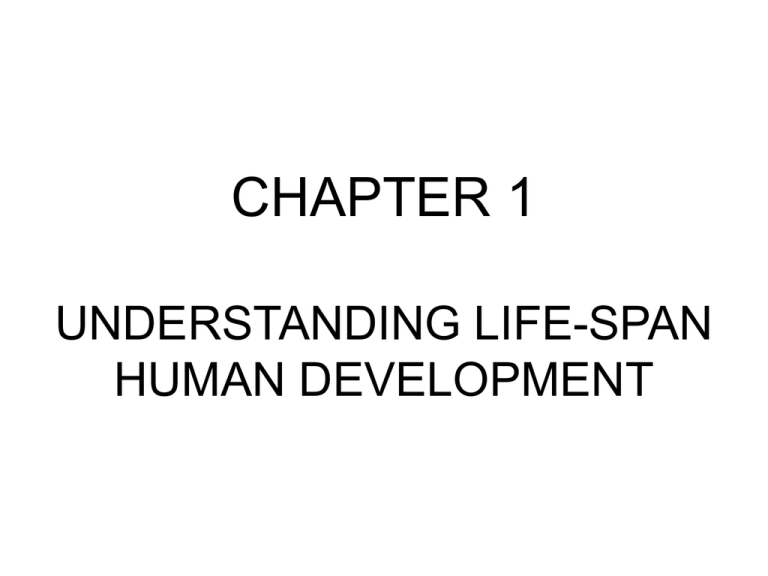
CHAPTER 1 UNDERSTANDING LIFE-SPAN HUMAN DEVELOPMENT Learning Objectives • How do developmental scientists define development? • What does the typical path of development look like across the life span? What is Development? • Systematic changes and continuities – In the individual – Between conception and death • “Womb to Tomb” • Three broad domains – Physical, Cognitive, Psychosocial Other Developmental Definitions • Growth: Physical changes that occur from birth to maturity • Aging: Positive and negative changes in the mature organism • Maturation: The biological unfolding of the individual genetic plan • Learning: Relatively permanent changes due to environmental experiences Age Grades, Age Norms, and the Social Clock • Age Grade: Socially defined age groups – Statuses, roles, privileges, responsibilities – Adults can vote, children can’t • Age Norms: Behavioral expectations by age – Children attend school • Social Clock: When things should be done – Early adulthood – time for 1st marriages • “Off time” experiences are more difficult Periods of Development • • • • • Prenatal period: conception to birth Infancy: birth to 18 to 24 months Early childhood: end of infancy to 5 or 6 years of age Middle and late childhood: 6 to 12 years of age Adolescence: transition from childhood to early adulthood,12 years of age to 20 years • Early adulthood: 20 to 40 years of age • Middle adulthood: 40-65 years of age • Late adulthood: begins in the 60s and lasts until death Learning Objective • How has our understanding of different periods of the life span changed historically? Phases of the Life Span • Before 1600: Children viewed as miniature adults • Modern View: Children innocent, need protection • Average life expectancy in 1900 was 47 year • In 2000 it was 77.5 years – Females: White=80, Black=76 – Males: White=75, Black=69 • Increasing population - age 65 and older Learning Objective • What are the main components of the nature-nurture issue? Framing the Nature/Nurture Issue • Nature: heredity – Maturational processes guided by genes – Biologically based predispositions – Biological unfolding of genes • Nurture: environment – Learning: experiences cause changes is thoughts, feelings, and behaviors • Interactionist view: nature & nurture interact Learning Objectives • What are the features of the bioecological model? • Why is this perspective important to our understanding of development? The Bioecological Model • Microsystem: Immediate environment • Mesosystem: Relationships • Exosystem: Social Systems • Macrosystem: Culture • This is an interactionist model • Urie Bronfenbrenner’s bioecological model of development pictures environment as a series of nested structures. The microsystem refers to relations between the developing person and her immediate environment, the mesosystem to connections among microsystems, the exosystem to settings that affect but do not contain the individual, the macrosystem to the broader cultural context of development, and the chronosystem to the patterning over time of historical and life events. Researchers face many challenges in studying the developing person in context. Learning Objectives • What is the science of life-span development? • What are the three goals of developmental psychology? • What are the seven assumptions of the modern life-span perspective on human development? Goals of Studying Life-Span Development • Description – Normal development, individual differences • Explanation – Typical and individually different development • Optimization – Positive development, enhancing human capacities – Prevention and overcoming difficulties Methods of Studying Life-Span Development • Historical – Baby Biographies: Charles Darwin – Questionnaires: G. Stanley Hall • Key Assumptions of Modern Life-Span Perspectives – Lifelong, multidirectional process – Gain and loss and lifelong plasticity – Historical/cultural contexts, multiple influences – Multi-disciplinary studies Learning Objectives • What is the scientific “mindset”? • How is the scientific method used to study development? Unique Challenges in Developmental Research • Infants and young children – Attention, instruction, answering questions may be difficult • Elderly Adults – Possible sensory impairments – Discomfort being studied, tested Conducting Developmental Research • Self-reports: interview, questionnaires, tests • Behavioral Observations (Experiments) – Naturalistic • Advantage: natural setting • Disadvantage: conditions not controlled – Structured (Lab) • Disadvantage: cannot generalize to natural settings • Advantage: conditions controlled Learning Objective • What are the essential features of the experimental method? • What sorts of information can be gathered from this type of study? • What are its strengths and weaknesses? The Scientific (Experimental) Method • Three Critical Features – 1. Manipulation of independent variable – 2. Random assignment of individuals to treatment conditions – 3. Experimental control • Quasi-Experiment: No random assignment • The scientific method in action Learning Objective • What are the important features of the correlational method? • What sorts of information can be gathered from this type of study? • What are its strengths and weaknesses? The Correlational Method • Determine if 2 or more variables are related • Correlation: A measure of the relationship – Can range from +1.0 to –1.0 – Positive: variables move in same direction – Negative: variables move in opposite dir. • No relationship if correlation is 0 • Cannot establish a causal relationship Learning Objective • What are the advantages and disadvantages of the crosssectional and longitudinal designs? • How does the sequential design resolve the weaknesses of these designs? Developmental Research Designs • Cross-Sectional Designs – >1 cohorts or age-groups studied – 1 time of testing – Studying age differences at any one time • Longitudinal Designs – <1 cohort – +1 time of testing – Study changes across time in one cohort • Cross-sectional and longitudinal studies of development from age 30 to Age, Cohort, and Time of Measurement Effects • Age effects: Changes which occur due to age • Cohort Effects: Born in one historical context – Changes due to differences in society – Disadvantage of cross-sectional design • Time of measurement effects: Historical – Take place at time of data collection – Disadvantage of longitudinal design • Conflicting findings of hypothetical cross-sectional and longitudinal studies of gender-role attitudes. How could the two studies produce different age trends? Sequential Designs • A combination of cross-sectional and longitudinal designs • Advantages of both designs • Gives information about – Which age-related trends are age effects – Which age-related trends are truly cohort effects – Which age-related trends are a result of historical events • A sequential study. This study begins in 1970 with a group of 30-year-olds studied longitudinally every 10 years thereafter. In 1980, a second longitudinal study is launched, in 1990 a third, and so on. Notice that at a point in time such as 2000 (blue shading) age groups can be compared in a cross sectional study. Notice too that 30-year-olds from different cohorts can be compared (orange shading). Learning Objective • What special challenges do developmental scientists face? • What challenges arise in studying development and how can scientists address these issues? Issues in Developmental Studies • Random sampling – Increases likelihood that sample is representative of population • Protecting rights of research participants – Must assess the benefit to risk balance • Researcher responsibilities – Informed consent, debriefing, protection from harm, confidentiality Cultural and Subcultural Sensitivity in Research • Variety of contexts considered • Culturally sensitive methods & measurements • SES particularly important • Ethnocentrism
